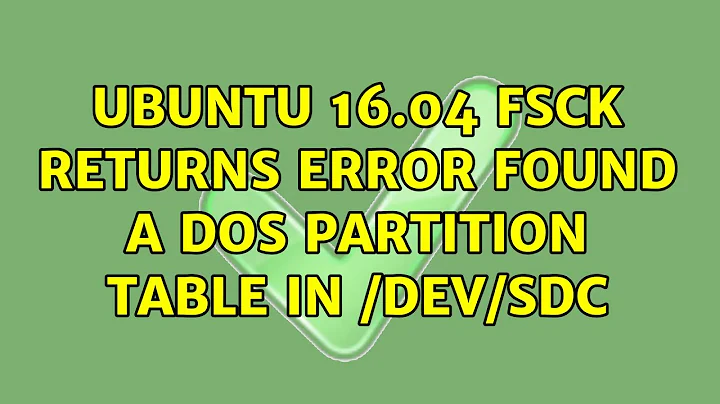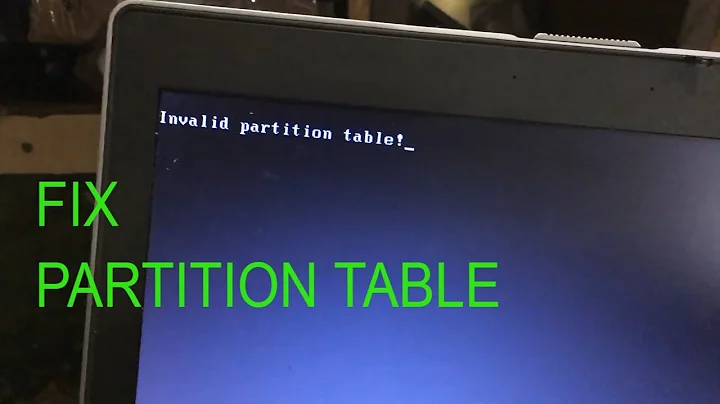Found a dos partition table in /dev/nvme1n1
Solution 1
The problem is that you have asked mke2fs to create a filesystem on the disk device itself (i.e. /dev/nvme1n1), where the partition table resides, rather than inside one of its partitions (i.e. /dev/nvme1n1p1). If you change the /dev/nvme1n1 to /dev/nvme1n1p1, it won't complain, and it should do what you want.
Solution 2
I'm not sure if this will help in your particular case, but I used this command to find an available NVME disk that hasn't had a partition created on it yet, assuming that there are at most two NVME disks and that the one used for the disk root has a *p1 partition created for it already:
$ lsblk | egrep -o 'nvme\w+' | grep -v $(lsblk | egrep -o 'nvme\w+p1' | egrep -o 'nvme.{3}')
# prints: `nvme0n1` or `nvme1n1`, depending on chance
Related videos on Youtube
Peter O Nilsson
Updated on September 18, 2022Comments
-
 Peter O Nilsson over 1 year
Peter O Nilsson over 1 yearWe have a setup at Amazon where we use the 16.04 LTS AMI. Today we planned to change to the newer 18.04 LTS AMI. We do this by updating the Cloudformation template with the latest AMI-ID. But when running the Cloudformation template we get this error at the backup volume setup,
2019-02-21 09:25:17,234 P8657 [INFO] Set up backup volume 2019-02-21 09:25:17,234 P8657 [INFO] mke2fs 1.44.1 (24-Mar-2018) 2019-02-21 09:25:17,234 P8657 [INFO] Found a dos partition table in /dev/nvme1n1 2019-02-21 09:25:17,234 P8657 [INFO] Proceed anyway? (y,N) 2019-02-21 09:25:17,235 P8657 [INFO] ------------------------------------------------------------ 2019-02-21 09:25:17,235 P8657 [ERROR] Exited with error code 1Doing the same thing with the latest 16.04 LTS AMI is working without any problems. The first thing that I saw was that the mke2fs versions are different, mke2fs 1.42.13 for 16.04 and mke2fs 1.44.1 for 18.04. Are there any big differences for the way those versions handles the filesystems? The volumes are already created, we just want them attached again.
Here is some output from the 16.04 LTS installation.
fdiskoutput:Disk /dev/nvme1n1: 1 TiB, 1099511627776 bytes, 2147483648 sectors Units: sectors of 1 * 512 = 512 bytes Sector size (logical/physical): 512 bytes / 512 bytes I/O size (minimum/optimal): 512 bytes / 512 bytes Disk /dev/nvme0n1: 32 GiB, 34359738368 bytes, 67108864 sectors Units: sectors of 1 * 512 = 512 bytes Sector size (logical/physical): 512 bytes / 512 bytes I/O size (minimum/optimal): 512 bytes / 512 bytes Disklabel type: dos Disk identifier: 0x30c871d7 Device Boot Start End Sectors Size Id Type /dev/nvme0n1p1 * 2048 67108830 67106783 32G 83 Linux Disk /dev/nvme2n1: 1000 GiB, 1073741824000 bytes, 2097152000 sectors Units: sectors of 1 * 512 = 512 bytes Sector size (logical/physical): 512 bytes / 512 bytes I/O size (minimum/optimal): 512 bytes / 512 bytespartedoutput:Model: NVMe Device (nvme) Disk /dev/nvme0n1: 34.4GB Sector size (logical/physical): 512B/512B Partition Table: msdos Disk Flags: Number Start End Size Type File system Flags 1 1049kB 34.4GB 34.4GB primary ext4 boot Model: NVMe Device (nvme) Disk /dev/nvme1n1: 1100GB Sector size (logical/physical): 512B/512B Partition Table: loop Disk Flags: Number Start End Size File system Flags 1 0.00B 1100GB 1100GB ext4 Model: NVMe Device (nvme) Disk /dev/nvme2n1: 1074GB Sector size (logical/physical): 512B/512B Partition Table: loop Disk Flags: Number Start End Size File system Flags 1 0.00B 1074GB 1074GB ext4fstaboutput:LABEL=cloudimg-rootfs / ext4 defaults,discard 0 0 /dev/nvme1n1 /backup auto noatime 0 0 /dev/nvme2n1 /data auto noatime 0 0-
oldfred about 5 yearsDrive is gpt only if you install in UEFI mode, partition using gpt or drive is over 2TiB. Gparted otherwise defaults to MBR and you have to choose gpt before starting to partition drive. If you have good backups and willing to reinstall boot loader(s) you can convert. Converting to or from GPT rodsbooks.com/gdisk/mbr2gpt.html
-
 Peter O Nilsson about 5 yearsThe installation is working when we use the 16.04 AMI, but not when we use the 18.04 AMI. We use the same CloudFormation template when we do the installation, we only change which AMI-ID to use. The volumes are already created and remains the same, they are just attached to the new installation.
Peter O Nilsson about 5 yearsThe installation is working when we use the 16.04 AMI, but not when we use the 18.04 AMI. We use the same CloudFormation template when we do the installation, we only change which AMI-ID to use. The volumes are already created and remains the same, they are just attached to the new installation. -
 Peter O Nilsson about 5 yearsAfter the setup had failed I tried to run the failing part manually. ` $ sudo mkfs -t ext4 /dev/nvme1n1 mke2fs 1.44.1 (24-Mar-2018) Found a dos partition table in /dev/nvme1n1 Proceed anyway? (y,N) y /dev/nvme1n1 is apparently in use by the system; will not make a filesystem here! `
Peter O Nilsson about 5 yearsAfter the setup had failed I tried to run the failing part manually. ` $ sudo mkfs -t ext4 /dev/nvme1n1 mke2fs 1.44.1 (24-Mar-2018) Found a dos partition table in /dev/nvme1n1 Proceed anyway? (y,N) y /dev/nvme1n1 is apparently in use by the system; will not make a filesystem here! ` -
 Peter O Nilsson about 5 yearsThe volume size is 1 TB, but I have tried with smaller ones with the same result. This problems only happens with the Ubuntu 18.04 AMI. I have also deleted the whole CloudFormation installation and started the installation from scratch wit ´h the 18.04 AMI. The result is the same as when I just did an update with the AMI of the running CloudFormation.
Peter O Nilsson about 5 yearsThe volume size is 1 TB, but I have tried with smaller ones with the same result. This problems only happens with the Ubuntu 18.04 AMI. I have also deleted the whole CloudFormation installation and started the installation from scratch wit ´h the 18.04 AMI. The result is the same as when I just did an update with the AMI of the running CloudFormation. -
 Peter O Nilsson about 5 yearsIt seems like that it attching the root device to nvme1n1 instead for the nvme0n1. That's the reason why it reports that there is dos partition table in nvme1n1. This only happens with the 18.04 AMI. ``` Model: Amazon Elastic Block Store (nvme) Disk /dev/nvme1n1: 34.4GB Sector size (logical/physical): 512B/512B Partition Table: msdos Disk Flags: Number Start End Size Type File system Flags 1 1049kB 34.4GB 34.4GB primary ext4 boot ```
Peter O Nilsson about 5 yearsIt seems like that it attching the root device to nvme1n1 instead for the nvme0n1. That's the reason why it reports that there is dos partition table in nvme1n1. This only happens with the 18.04 AMI. ``` Model: Amazon Elastic Block Store (nvme) Disk /dev/nvme1n1: 34.4GB Sector size (logical/physical): 512B/512B Partition Table: msdos Disk Flags: Number Start End Size Type File system Flags 1 1049kB 34.4GB 34.4GB primary ext4 boot ```
-




